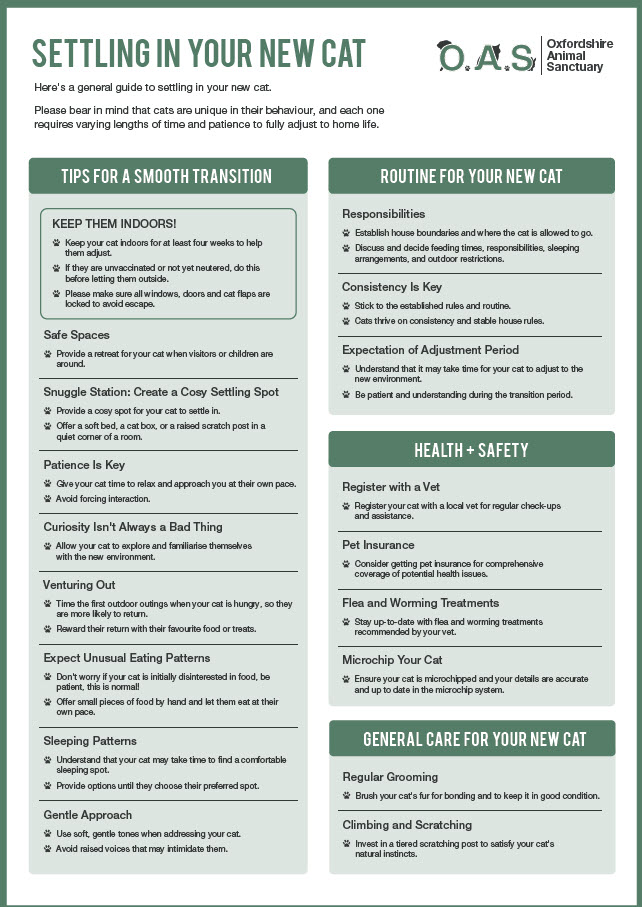Bringing home a rescue cat is a thrilling experience for any pet lover. However, for your new feline friend, this transition can be quite daunting due to unfamiliar sights, smells, and people. Cats are unique in their behaviour, and each one requires varying lengths of time and patience to fully adjust to home life.
To smoothen this journey from the cattery to home for both you and your new cat, here are some insightful tips:
Safe and Sound
Cats thrive in a comfortable environment. Give your new cat ample time to acclimate to its new home and provide a cosy spot to settle in. This could be a soft bed, a cat box, or a raised scratch post located in a quiet corner of a room where the cat will spend most of its time, such as the kitchen or living room.
Patience Is Key
Don’t force interaction with the cat. If they seem reserved, it’s crucial to give them time to relax and approach you at their own pace. Remember, this is a significant transition, and forcing intimacy can do more harm than good.
Curiosity Isn’t Always a Bad Thing
Cats are naturally inquisitive. Your new cat will likely inspect every inch of your home in the coming days, which is a good sign as they are trying to familiarise themselves with their new environment.
Indoor Time
Ensure to keep your new cat indoors for a minimum of four weeks. This helps them get accustomed to their new surroundings. If you let them out prematurely, they might not find their way back home due to unfamiliarity.
If you are adopting kittens, do not let them outside until they have had their full course of initial vaccinations and have been neutered.
Venturing Out
When it’s time for your cat to explore the outdoors, it’s best to time this outing so they haven’t been fed. The call of hunger will likely prompt them to return home. Upon their return, reward your cat with some of their favourite food or treats. This positive reinforcement encourages them to stay close to home and return each day.
Eating Habits
Don’t be alarmed if your new cat seems disinterested in food initially. Cats tend to lose their appetite when they are nervous or stressed. Be patient and try offering small pieces of food by hand, but refrain from forcing them to eat. Once they feel comfortable, their appetite will return naturally.
Sleeping Patterns
It’s common for cats to be unsettled overnight for a few days until they find a comfortable sleeping spot. Cats can be quite picky about where they sleep, so provide them with options until they choose a preferred spot.
Gentle Approach
Lastly, always use soft, gentle tones when addressing them. Avoid any raised voices in the home. Remember, everything is new and potentially intimidating to them.
Bringing home a new cat is an exciting journey filled with unique challenges. With patience, understanding, and gentle guidance, you’ll create a warm, loving home that your new feline friend can’t resist.
Establishing a Routine for Your New Cat
Establishing a routine is vital in helping your new cat feel safe and comfortable in its new environment. Consistency provides stability and can help your cat to adjust more quickly to its new home. Here’s how you can establish a routine and set house rules for your new feline friend:
Family Meeting
Having a family meeting before the arrival of your new cat can help set expectations and create rules. Address the following:
- House Boundaries: Determine where the cat is allowed to go in the house and where it is not. Establishing these boundaries early on helps your cat understand its new environment better and prevents any unwanted behaviour.
- Feeding Times: Decide who will feed the cat and at what times. Cats usually do well with consistent feeding times, which can help prevent overeating and obesity.
- Sleeping Arrangements: Decide on a sleeping spot for your cat. This could be a comfortable cat bed, a cosy corner in a room, or even a specific piece of furniture. Cats appreciate having a designated spot to rest and sleep.
- Outdoor Time: Ensure that everyone in the house knows that the cat should not be allowed outside for the first four weeks. This will allow the cat to get familiar with the home environment before venturing outside.
Consistency Is Key
It’s important to stick to these rules and the established routine. Cats thrive on routine, and having consistent house rules can help your new cat settle more quickly and feel more comfortable in its new home.
Expectation of Adjustment Period
Remember that the home routine is going to be significantly different from what your cat has been used to, especially if they’re coming from a shelter or rescue organisation. It may take some time for them to adjust to the new environment, schedule, and house rules. Patience and understanding during this transition period can go a long way in helping your cat feel at ease.
Adopting a new cat is a fulfilling journey that requires time, patience, and a loving environment. As long as you stick to a consistent routine, set clear boundaries, and offer ample patience and understanding, your new furry friend will soon feel right at home.
Ensuring Your New Cat’s Health and Safety
Ensuring your new cat’s health and safety is a critical part of helping them settle into their new home. Here’s how you can take proactive steps to keep your cat healthy and safe:
Register with a Vet
We recommend registering your new cat with your local vet as soon as possible. This will ensure they’re on the system for their annual boosters and will simplify the process if you need veterinary assistance or if any health issues arise.
Pet Insurance
Getting pet insurance for your new cat is also highly advised. Veterinary bills can become quite costly if your cat falls ill. Insurance can cover the cost of many different ailments, but always remember to check the fine print to see what’s covered. Look for a “Lifetime Cover” policy for comprehensive protection.
Flea and Worming Treatments
Staying up-to-date with flea and worming treatments is crucial for maintaining your cat’s health. Your cat’s next due date for these treatments will have been provided to you at the time of adoption. Speak with your vet about the best brands to use. Prescription treatments are usually more effective than over-the-counter ones.
Microchipping and Collars
Unless too young at the time of adoption, your new cat will come to you microchipped. Microchips are an effective way to keep track of your pet, but it’s also a good idea to have a collar on your cat to make them easily recognisable.
You can get collar tags for cats where you can put your contact information or your vet’s contact information. This can be especially helpful if your cat strays at any point, enabling anyone who finds your cat to contact you directly.
Taking these steps will not only help ensure your cat’s health and safety but also give you peace of mind. Adopting a new cat can bring so much joy and happiness, and with careful attention to their health needs and safety, you can look forward to many happy years together.
General Care for Your New Cat
While every cat has unique needs and personality traits, certain general care practices can help ensure the comfort and happiness of your new feline friend. Here are some tips to consider:
Regular Grooming
Although cats are excellent self-groomers, taking the time to brush your cat can be a bonding experience. Not only does this keep their fur in good condition, but it also helps build trust and rapport between you and your cat. Many cats relish the attention that comes with grooming, turning it into a pleasant, relaxing activity.
Safe Spaces
Always ensure your cat has the option to retreat when you have visitors, especially around children. Cats can easily become overwhelmed by too much attention or activity, so having a safe space to escape to is important. It’s crucial to avoid situations where the cat feels cornered or threatened, as this can lead to defensive behaviour, such as scratching or biting.
Climbing and Scratching
Cats have a natural instinct to climb and scratch. Investing in a tiered scratching post can satisfy both of these urges. These posts provide a perch for cats to sit up high, observing their territory, and a safe and acceptable place for them to exercise their claws, potentially saving your furniture from claw marks!
The cattery staff should provide you with detailed information about the cat before you take it home. They will aim to give you a comprehensive understanding of what to expect once the cat has settled into your home.
Remember, integrating a new cat into your home is a process that requires patience, understanding, and love. With these care tips in mind, you’re well on your way to creating a nurturing and comfortable environment for your new feline friend. Enjoy the journey of getting to know your cat and building a bond that can last a lifetime.
A Heartfelt Thank You
We extend our heartfelt gratitude to you for welcoming a rescue cat into your home and heart. The decision to adopt a rescue cat not only transforms the life of the animal but also brings immeasurable joy and companionship to your home.
We’re excited to hear about your journey with your new furry friend. We’re especially interested in knowing how they are settling into their new home, your experiences, and any adorable moments you’ve shared together.
You can reach out to us via phone or email, or connect with us on our Facebook page. Your updates not only warm our hearts, but they also inspire others to consider adopting rescue cats, extending the chain of compassion and care.
Once again, thank you for choosing adoption. Here’s to many years of purrs, affectionate nussles, and shared happiness with your new cat.
Here’s a handy checklist for you to download as a reminder of all the points above.



